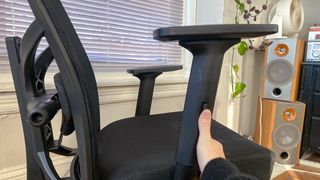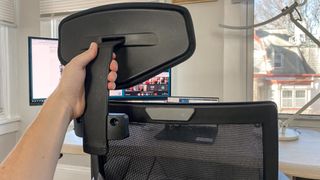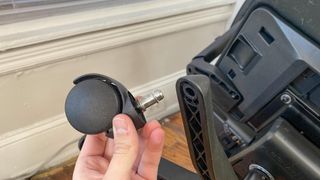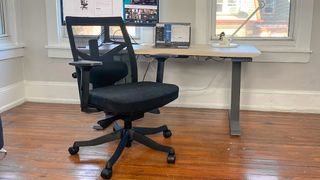Budget office chairs aren’t always known for their adjustability. Luckily, this low-cost model from Uplift, the Facet, has nine adjustment points, none of which are frilly or unnecessary. It has some of the most pronounced lumbar support on any chair I’ve tested, and the whole thing fits wonderfully in my ever-too-crowded office.
Unfortunately, this chair is way too stiff for me. I don’t think this disqualifies it as a quality budget pick, but it’s worth knowing before ordering one that it’s best for people who prefer a hard seat cushion and backrest.
This Uplift Facet Ergonomic Chair review will help you decide if this is the best budget office chair for your needs or if it’s worth spending a bit more on one of the best office chairs overall.
Uplift Facet Ergonomic Chair: Cheat Sheet
- What is it? A budget-friendly mesh-backed office chair with nine points of ergonomic adjustment and a removable headrest
- Who is it for? Budget conscious home office workers who want more adjustability and don’t mind a stiff seat
- What does it cost? The Facet costs $279 on Uplift’s site.
- What do we like? It has breathable mesh for the backrest, adjustable lumbar support and backrest height, and a headrest that’s easy to install and remove.
- What don’t we like? The seat cushion is rock-hard, the backrest could be a bit wider for broad shoulders, and the tilt resistance is a tad too low.
Uplift Facet Ergonomic Chair: Specs
Swipe to scroll horizontally
| Seat Height | 16.9-20.7 inches |
| Maximum load | 250 pounds |
| Weight | 39.6 pounds |
| Materials | Mesh back, fabric seat with polyurethane foam cushion, nylon base |
| Warranty | 15 years |
Uplift Facet Ergonomic Chair: The ups
This chair has plenty going right for it, including many features I wouldn’t have expected for a chair at this price, especially in terms of adjustability. These are some of the high notes this chair hits in stride.
Great adjustability

For a sub-$300 chair, I couldn’t have been happier with the extent to which this chair is adjustable. You can fidget with seat height, backrest height, armrest height, tilt angle, and seat fore-aft positioning. There’s just enough adjustability to feel like you can actually tailor this seat to your needs, but it’s not a huge mess of knobs and levers that you have to hunch over and check with your eyes before every tweak.
The armrest height adjustment was an especially welcome feature on this chair, as it’s not always common on low-price models like the Facet. Heck, there are plenty of top-shelf Herman Miller chairs that charge extra for this functionality.
Lumbar support

To expand even further on this chair’s adjustability, I want to point out the incredibly sturdy lumbar support on this chair. I tend to need a lot of it, and I found that this chair can exceed even my preferences for a pronounced lower back curve. You can toy with it on the fly using a big knob that juts out of either side of the backrest, and you can change its vertical positioning by sliding the entire backrest up and down.
It’s worth mentioning that this lumbar support, while sturdy, is also incredibly stiff. That said, the rest of this chair is also incredibly stiff (more on that later), so I appreciate that it’s congruent with the rest of the design.
Optional headrest

I’m not a headrest user myself, so I never installed it on this chair, but I was happy to see that the option comes standard. And unlike some other chairs we’ve tested that have headrests as a somewhat auxiliary feature, you can actually adjust it. You can move it vertically, and you can change the angle by a few degrees.
Don’t want a headrest on your Facet? You can order it without a headrest from the get-go, or you can remove it whenever you want and fill the gap with a conveniently included gray cover piece. Once you have that cover installed, it’s like the headrest was never there.
Uplift Facet Ergonomic Chair: The downs
There’s nothing shocking about a budget chair having to make a few sacrifices to hit itsprice point, but there are a few gripes I had with this chair that shan’t go unmentioned. These are some of the most notable.
Frustrating assembly

This may be an issue of contrast, as I assembled this chair on the same day as the three-piece Autonomous ErgoChair Ultra 2, but I did not love putting the Facet together. It has a fairly standard amount of pieces, and I’m happy the box managed to fit through my apartment’s notoriously narrow front door, but some finer details of the assembly process left my confidence a bit shaken.
First and foremost, the armrests attach using four bolts that screw into the underside of the main body. Once installed, these puppies aren’t going anywhere, but I spent an arduous 10 minutes trying to work an allen wrench into the inner bolts with the adjustment knobs in the way. Worse yet, I struggled for even longer to get the bolts threaded properly in the first place because the holes on the armrests didn’t perfectly line up.
What followed was an unnecessarily long song and dance involving loosening all the bolts, wiggling everything around, and seeing if I could start the threads again. It’s not really a complaint that affects the functionality of the assembled chair, but the process still wrought enough ire from my embittered spirit to warrant a mention here.
Stiff seat

At the end of the day, we want the chair we’re sitting in all day to be comfortable, no? Here’s where I ultimately ran into my ain issue with the Facet: I just didn’t like how the cushioning felt. I don’t want to knock this chair too hard since it’s clearly a budget option, but I found myself feeling pretty frustrated by how little I settled into the seat. There are 2.5 inches of foam on itsthis cushion, but it feels like I’m stuck on top of it instead of sinking into it.
I do think the extent of this chair’s adjustability makes this chair workable comfort-wise, but I ultimately think I’d be willing to invest in a more expensive model with nicer foam in the future. We’re testing some higher-end picks from Uplift right now as well, and we’ll be sure to take note of any differences in the cushioning.
Uplift Facet Ergonomic Chair: Verdict
Ultimately, I don’t think this chair is the one for me, but nevertheless I appreciate what it’s trying to do. As such, I hesitate to say that this is a bad chair. It’s far more adjustable than many other chairs at its price, it has some of the best lumbar support of any chair I’ve had on hand, and it’s small enough to fit comfortably in my office next to several other chairs I’m actively testing. It’s just too dang stiff for my liking.
All of that said, I’m sure there are folks out there who prefer a stiffer seat than me. I like to sink nice and deep into my chair whenever possible, but it’s not uncommon for others to like the sprightly feeling that comes with firmer foam. If that sounds like it’s up your alley, I wouldn’t write the Facet off just yet.





















 English (US) ·
English (US) ·